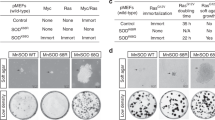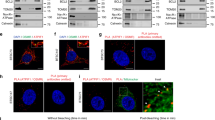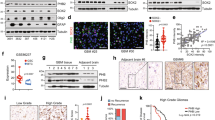Abstract
Manganese superoxide dismutase (MnSOD) has been previously shown to suppress the malignant phenotype of human melanoma and breast cancer cells. To test the possible role of MnSOD in glioma malignancy, MnSOD was overexpressed in wild type human glioma U118 cells and subcloned U118-9 cells by transfection of human MnSOD cDNA. The MnSOD-transfected cell lines demonstrated expression of exogenous (plasmid) MnSOD mRNA, increase in MnSOD immunoreactive protein, and a three- to eightfold increase in MnSOD enzymatic activity. The MnSOD overexpressing cell lines became less malignant as demonstrated by requiring a higher serum concentration to grow in vitro and much slower tumor growth in nude mice than the parental and neo control cell lines. These findings further support the hypothesis that MnSOD may be a tumor suppressor gene in a wide variety of human tumors.
This is a preview of subscription content, access via your institution
Access options
Subscribe to this journal
Receive 50 print issues and online access
$259.00 per year
only $5.18 per issue
Buy this article
- Purchase on Springer Link
- Instant access to full article PDF
Prices may be subject to local taxes which are calculated during checkout
Similar content being viewed by others
Author information
Authors and Affiliations
Rights and permissions
About this article
Cite this article
Zhong, W., Oberley, L., Oberley, T. et al. Suppression of the malignant phenotype of human glioma cells by overexpression of manganese superoxide dismutase. Oncogene 14, 481–490 (1997). https://doi.org/10.1038/sj.onc.1200852
Received:
Revised:
Accepted:
Issue Date:
DOI: https://doi.org/10.1038/sj.onc.1200852
Keywords
This article is cited by
-
A recombinant trans-membrane protein hMnSOD–R9 inhibits the proliferation of cervical cancer cells in vitro
Molecular and Cellular Biochemistry (2014)
-
Purification and biochemical characterization of manganesecontaining superoxide dismutase from deep-sea thermophile Geobacillus sp. EPT3
Acta Oceanologica Sinica (2014)
-
Human Wharton's Jelly Stem Cells, its Conditioned Medium and Cell-Free Lysate Inhibit the Growth of Human Lymphoma Cells
Stem Cell Reviews and Reports (2014)
-
Hematopoietic Stem Cell Regeneration Enhanced by Ectopic Expression of ROS-detoxifying Enzymes in Transplant Mice
Molecular Therapy (2013)
-
Effects of manganese superoxide dismutase (MnSOD) expression on regulation of esophageal cancer cell growth and apoptosis in vitro and in nude mice
Tumor Biology (2013)



